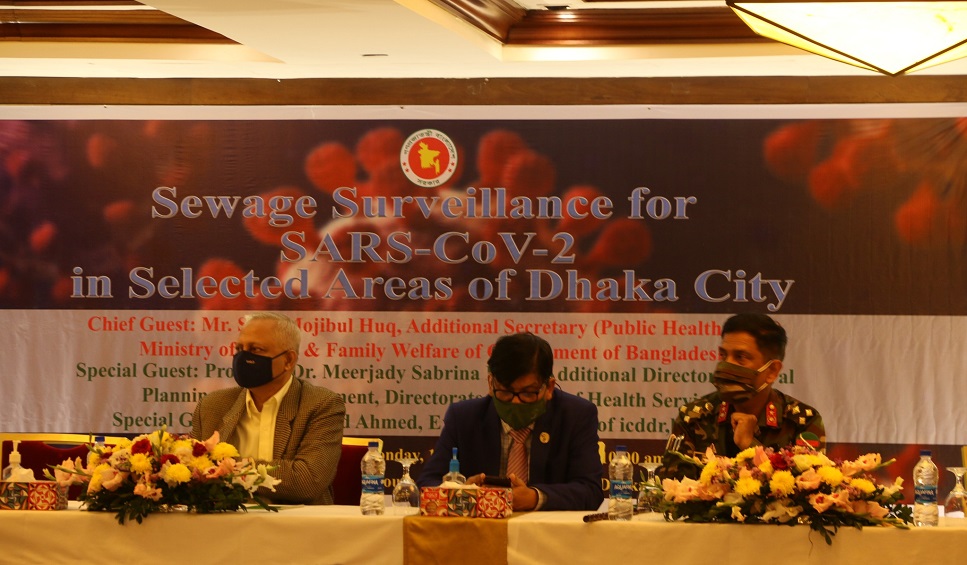Staff Correspondent
Published:2021-12-14 13:42:02 BdST
Dhaka’s sewage surveillance for corona offers an insight into community transmission
Scientists conducted first ever sewage surveillance system to trace out and provides a measure of how many infected people there are in specific area.
icddr,b, University of Virginia, USA; Imperial College London, UK; Institute of Epidemiology Disease Control and Research (IEDCR), Bangladesh; the Directorate General of Health Services (DGHS), Bangladesh and partners have presented the first ever sewage surveillance system for SARS-CoV-2 in Dhaka, at a dissemination seminar held at Six Seasons Hotel, Dhaka.
This new public health tool can successfully track COVID-19 through detecting SARS-CoV-2 RNA in sewage or wastewater.
The sewage surveillance system covers 33 different catchment areas in eight wards of the Dhaka North City Corporation (DNCC) and was started in June 2019, initially for poliovirus (Sabin vaccine strains), antimicrobial resistance genes, and other enteric pathogens.
When the COVID-19 pandemic broke out in March 2020, the scope of the system was immediately expanded to test samples for SARS-CoV-2 virus. Since then, weekly sewage samples are collected from each catchment area and the amount of viral pathogen in the system is quantified using a method called reverse transcription quantitative PCR (qRT-PCR).
The viral load associated with each sample collection site is then connected to its watershed through sewage and drainage line tracing and provides a measure of how many infected people there are in the area. Finally, all these data and analysis are presented through an online dashboard hosted at the following link https://dhakacovidtracker.research.virginia.edu/
The surveillance system works as an early indicator, which allows public health officials to predict an increasing or decreasing trend of infection around a week prior to the rise or fall in COVID-19 cases.
With this knowledge, public health officials can visualise, which regions have higher prevalence of COVID-19 and can allocate more of their limited testing resources to those areas and prevent further transmission.
They can also implement public health interventions specific to a particular location and keep the citizens of the community as safe as possible.
Dr Rashidul Haque, Senior Scientist at iccdr,b said “COVID-19 disease diagnosis currently relies on sick people to seek medical help, but many sick people do not seek help, many are also asymptomatic, thus authorities often remain unaware of the total number of infected individuals, leading to an underestimation of the community transmission of COVID-19. Active surveillance system like ours, which do not rely on the actions of sick people can help address outbreaks of infectious disease, such as COVID-19 more effectively.”
“This type of research being done on the sewerage system is very new to Bangladesh. We may be able to disseminate the findings internationally and show the world how we can do surveillance through sewage systems. We also need to disseminate the results at the grassroots level so that we can change the behaviour of people,” said Mr Syed Mojibul Huq, Additional Secretary (Public Health Wing), Ministry of Health & Family Welfare of Bangladesh.
“In developing countries like Bangladesh this type of research is necessary. As the Covid-19 pandemic has led to the loss of thousands of lives, we need to find ways that can assist us in surveillance and containment” said Brigadier General Md Zobaydur Rahman, Chief Health Officer, Dhaka North City Corporation.
“This will definitely contribute in creating awareness and the research findings can be translated into action and impact policy and programmes regarding Covid-19 containment” – he added.
Speaking on the prospects of detecting emerging strains and variants, Dr Mami Taniuchi, Associate Professor from the University of Virginia said, “We are establishing a robust system to track circulating strains and variants of SARS-CoV-2. We initiated the work and are presently analysing the data. Hopefully, these insights will also help identify changes in transmission more accurately and help strengthen public health measures and surveillance for COVID-19.”
Commenting on the prospects of the sewage surveillance in Dhaka, Professor Dr Meerjady Sabrina Flora, Additional Director General, DGHS said, “The COVID-19 pandemic is not ending anytime soon, we need to get ahead of it and thus must keep the rapid community transmission in check. As the number of asymptomatic cases are more than symptomatic cases, this type of surveillance system is really useful for the government of Bangladesh. It would be of great interest if we could have further analysis and scale up the surveillance system all over Dhaka city.”
icddr,b’s Executive Director, Dr Tahmeed Ahmed speech on the importance of using this surveillance system efficiently and said, “Bangladesh has done pretty well in containing Covid-19 because of the efforts of the government. The different types of innovative research being done in Bangladesh on Covid-19 is also supporting the government in its efforts. This type of surveillance system is an example of the type of research that can be efficiently used in the containment efforts of Covid-19.”
The dashboard and sewage surveillance pilot study in Dhaka will hopefully prove that specific and distinct representation of SARS-CoV-2 is possible in heavily populated countries and will justify efforts to increase equitable representation of COVID-19 in developing countries.
The sewage surveillance study was funded by the Bill and Melinda Gates Foundation.
Unauthorized use or reproduction of The Finance Today content for commercial purposes is strictly prohibited.


